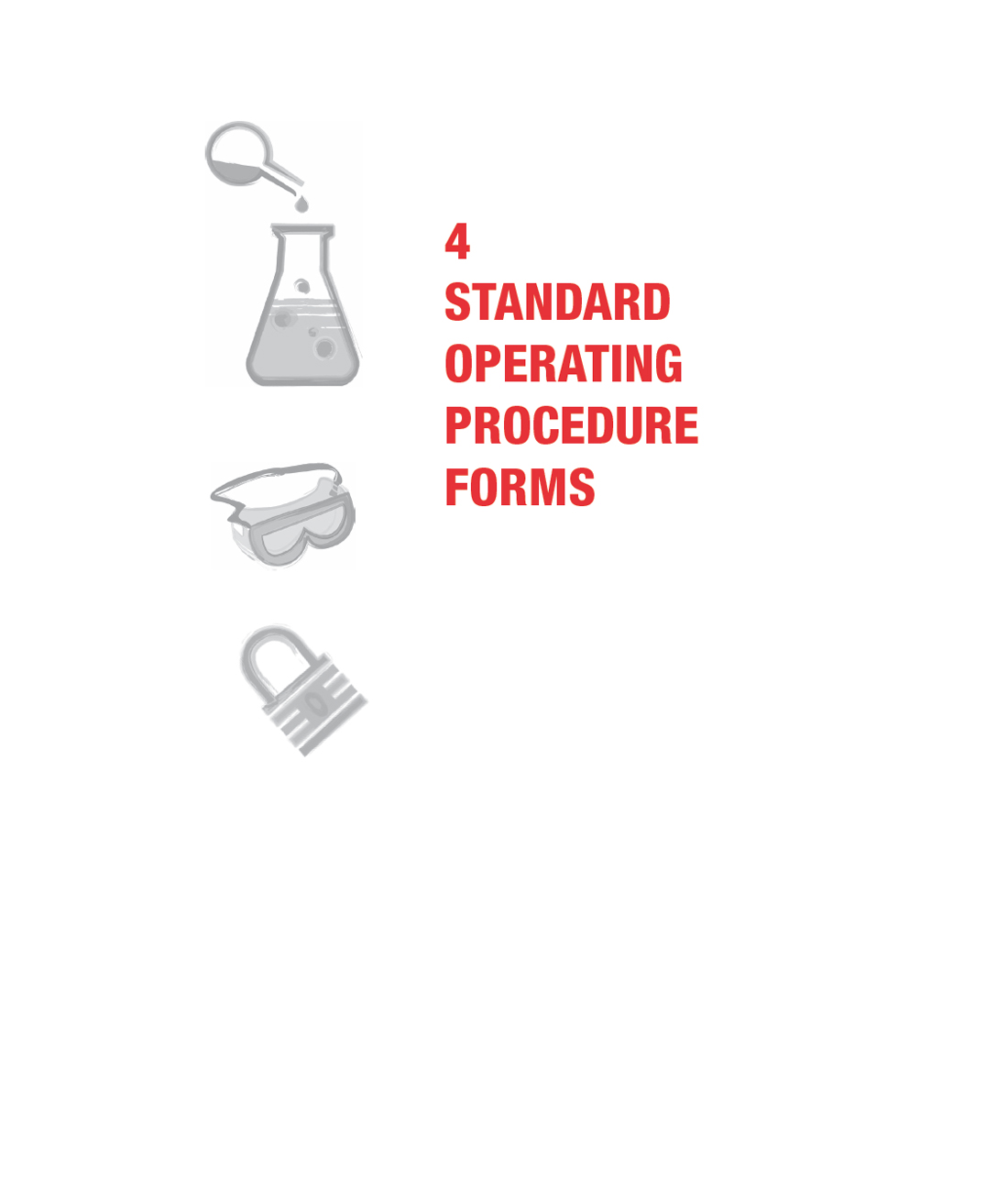This page intentionally left blank.
INTRODUCTION
Safe and secure execution of experiments will minimize health and safety risks to laboratory personnel and those in the surrounding area. When institutional laboratory standards are not sufficient to mitigate the risks, laboratory personnel may use the Moderate Risk Standard Operating Procedure (SOP) or the High Risk SOP for the specific process.
MODERATE RISK STANDARD OPERATING PROCEDURE
A Moderate Risk SOP is suggested for processes, experiments, or manipulations that pose moderate risks and that call for protective steps beyond those dictated by accepted laboratory standards. The Moderate Risk SOP form is a condensed version of the High Risk SOP.
Moderate Risk Standard Operating Procedure Form
Implementation of the Moderate Risk SOP is suggested for processes, experiments, or manipulations that pose moderate risks and that call for protective steps beyond those dictated by accepted laboratory standards. They are intended to limit the potential for injury, equipment damage, or environmental impact.
1. TITLE AND DESCRIPTION OF EXPERIMENT OR PROCESS:
2. PREPARER(S):
3. LOCATION:
4. AUTHORIZED PERSONNEL (WITH CONTACT INFORMATION)
a. PRINCIPAL INVESTIGATOR (PI)/SUPERVISOR:
b. STUDENT(S)/TECHNICIAN(S)/OPERATOR(S):
c. OTHERS TO BE NOTIFIED (e.g., other workers in the same laboratory, or other members of the research group):
5. POTENTIAL HAZARDS:
6. DESCRIBE ALL SPECIAL REQUIREMENTS FOR SPECIFIC ITEMS THAT REQUIRE A GREATER LEVEL OF SAFETY
| Planned chemicals involved |
|
| Personal protective equipment |
|
| Engineering and environmental controls |
|
| Operational ranges and conditions |
|
| Special handling and storage requirements |
|
| Spill and accident procedure as needed |
|
| Waste handling and disposal |
7. IDENTIFY ANY TRAINING NEEDS
| Specific training required |
|
| Users requiring training |
|
| Date completed |
8. VERIFICATION AND REVIEW
By signing below, you acknowledge that you have read, understand, and approve the SOP.
| PI name (please print) | |
| Pl signature | |
| Safety staff name (please print) | |
| Safety staff signature | |
| Current date | |
| Date of SOP expiration (e.g., 1 year) |
9. LIST OF REFERENCES (include Safety Data Sheets, Globally Harmonized System, any outside personnel consulted in preparation of document, peer reviewers, etc.)

Moderate Risk Standard Operating Procedure Review and Modifications Log
| Were modifications made to current SOP? | Yes |
| If no, then list date of approval | |
| Last reviewed by (please print) | |
| If yes, then list and describe modifications |
| Were modifications made to current SOP? | Yes |
| If no, then list date of approval | |
| Last reviewed by (please print) | |
| If yes, then list and describe modifications |
| Were modifications made to current SOP? | Yes |
| If no, then list date of approval | |
| Last reviewed by (please print) | |
| If yes, then list and describe modifications |
The worker will first record basic information on the Moderate Risk SOP form, including the title of the experiment or operation, the name of the person(s) preparing the SOP, where the experiment or procedure will take place, and the names of authorized personnel.
Identifiable potential hazards (Step 5) are those that laboratory personnel are aware of before carrying out the experiment or procedure. Hazards may be posed by any chemical of concern, particularly if handled by inexperienced workers, as well as any reaction products that may be generated either in situ or as intended products or byproducts.
The most crucial item in the Moderate Risk SOP is Step 6: “Describe all special requirements for specific items that require a greater level of safety.” Laboratory personnel are encouraged to review all available resources (see Appendix B), such as the literature, existing SOPs, and Safety Data Sheets (SDSs), and consult with other members at the institution to complete Step 6 with as much detail as possible.
- Personal protective equipment (PPE) includes gloves, goggles, safety glasses, face shield, laboratory coat, special shoes (i.e., toe protection), respirator, and other items required for the experiment or procedure.
- Engineering and environmental controls refer to the space and environment in which the experiment or procedure will take place, such as a fume hood or an inert atmosphere.
- Special handling and storage requirements are described in detail to prevent spills or accidents. Handling and storage procedures include, for example, use of specific glassware (e.g., open container, Schlenk flask) or techniques that can minimize spills and accidents.
- Spill and accident procedures should be listed in the event of an accident.
- Procedures for handling and disposing of waste will assist the laboratory worker in the proper and safe disposal of the chemical reagents, solvents, and byproducts and any disposable equipment, such as paper towels and pipettes.
After the form has been completed, senior staff will review the SOP for completeness and accuracy. A modifications log appears at the end of the form for laboratory personnel who carried out the same process but modified or updated some of the information on the form. Each facility is responsible for establishing what necessitates a modification to the SOP. Supervisors, professors, and chemical hygiene officers are all acceptable positions for review and approval of modifications and updates.
HIGH RISK STANDARD OPERATING PROCEDURE
If after completing the Risk Assessment Flowchart, the laboratory worker has determined that the chemical(s) or conditions pose a high risk for hazard, then he or she should develop a High Risk SOP. The High Risk SOP can be applied to processes, experiments, or manipulations that are not addressed by the institution’s acceptable laboratory standards and are considered to present high risks for both inexperienced and experienced laboratory workers.
As with the Moderate Risk SOP, the High Risk SOP form begins with basic information (i.e., experiment title, name of the person preparing the SOP, experiment location, and names of authorized personnel). The second item calls for a description of the techniques and manipulations to be employed and any specific training that is required to complete the experiment or procedure safely, such as for proper use of a pressurized gas or for manipulations on a Schlenk line.
High Risk Standard Operating Procedure Form
Implementation of the High Risk SOP is suggested for processes, experiments, or manipulations that pose high risks and that call for protective steps beyond those dictated by accepted laboratory standards. They are intended to limit the potential for injury, equipment damage, or environmental impact.
1. TITLE AND DESCRIPTION OF EXPERIMENT OR PROCESS:
2. PREPARER(S):
3. LOCATION:
4. AUTHORIZED PERSONNEL (WITH CONTACT INFORMATION)
a. PRINCIPAL INVESTIGATOR (PI)/SUPERVISOR:
b. STUDENT(S)/TECHNICIAN(S)/OPERATOR(S):
c. OTHERS TO BE NOTIFIED (e.g., other workers in the same laboratory, or other members of the research group):
5. IDENTIFY ANY TRAINING NEEDS
| Experimental techniques |
|
| Specific training required |
|
| Users requiring training |
|
| Date completed |
6. DETAILED PROCESS DESCRIPTION
| List ranges for variables |
Temperature: |
| Pressure: | |
| Viscosity: | |
| Flammability: | |
| Other: | |
| List operational ranges and conditions | |
| Materials to be used | Chemicals: |
| Equipment: |
DETAILED PROCEDURE:
Column A: Process Steps provide step-by-step normal operating procedures, including the transfer of chemicals between or across laboratories, production of gases, workup of products, and preparation of wastes.
Column B: Safety Notes describe how the risk can be mitigated (i.e., minimize clutter, control flammables, secure gas cylinders, ensure good condition of pump belts).
| Column A: Process Steps | Column B: Safety Notes | |
| 1.0 |
e.g., specific personal protective equipment requirements | |
| 1.1 |
||
| 1.2 |
| 2.0 |
||
| 2.1 |
||
| 2.2 |
| 3.0 |
||
| 3.1 |
||
| 3.2 |
| 4.0 |
||
| 4.1 |
||
| 4.2 |
7. ENGINEERING CONTROLS (check all that apply and provide a detailed description)
| Engineering Controls | Check box if applicable | Description |
| Ex. Glove box | Use inert air (N2 or Ar) | |
Fume hood or glove box |
|
|
| Special ventilation | ||
| HEPA-filtered vacuum lines | ||
| Non-reactive containers | ||
| Pressure relief devices | ||
| Temperature control | ||
| Bench paper, pads, plastic-backed paper | ||
| Special signage | ||
| Safe sharp devices | ||
| Other safety devices used: |
8. PERSONAL PROTECTIVE EQUIPMENT (check all that apply)
| Personal Protective Equipment | Check box if applicable | Description |
| Gloves | ||
| Lab coats | ||
| Suits | ||
| Aprons | ||
| Long pants | ||
| Close-toed shoes | ||
| Long sleeves | ||
| Safety glasses | ||
| Goggles | ||
| Face shields | ||
| Respirators (include cartridge type and cartridge change-out schedule) | ||
| Hearing protection (include level of protection needed) | ||
| Special equipment (i.e., blast shields, special enclosures) | ||
| Other PPE |
9. WORK PRACTICE CONTROLS
| Controls | Description |
| Designated areas |
|
| Procedures for requesting emergency assistance |
|
| Emergency phone numbers |
|
| Locations of fire alarms, fire extinguishers, fire blankets, eye washes, showers, etc. |
|
| Emergency responders |
|
| Workers on shifts |
|
| Training on all experimental techniques and experiments |
|
| Restricting access; locks |
|
| Housekeeping |
|
| Lockout/tagouta procedure plan |
|
| After-hour procedures |
|
| Preventive maintenance |
a Lockout/tagout refers to specific procedures to safeguard researchers from an unexpected startup of machinery and equipment, or a release of hazardous energy during service or maintenance activities.
10. MONITORING
| Monitoring | Description |
| Personnel exposure monitoring | e.g., wearable sensors for toxics, radiation badges |
| Leak checking |
|
| Gas and spill release monitoring |
|
| Temperature and pressure |
|
| Alarms |
11. SPILL AND ACCIDENT PROCEDURES
| Description and Location | |
| Secondary containment |
|
| Spill kits |
|
| Emergency shutdown procedures |
|
| Process shutdown |
|
| Persons to inform |
12. WASTE DISPOSAL PROCEDURES (include segregation of acids, bases, halogenated compounds, PPE, collection and transport procedures, proper documentation, regulations, etc.)
13. STORAGE (check all that apply)
Ventilated enclosures ![]()
Refrigeration ![]()
Gas cabinet ![]()
Compliance with regulations ![]()
Expiration date:
Inventory:
Other:
14. TRANSPORTATION PROCEDURES:
(e.g., secondary container for transporting between and across laboratories; secondary containment for experimental apparatus)
15. PEER REVIEW
| Name (please print) | |
| Signature | |
| Date | |
| Notes |
| Name (please print) | |
| Signature | |
| Date | |
| Notes |
16. VERIFICATION AND REVIEW
By signing below, you acknowledge that you have read, understand, and approve the SOP.
| PI name (please print) | |
| PI signature | |
| Safety staff name (please print) | |
| Safety staff signature | |
| Current Date | |
| Date of SOP expiration (e.g., 1 year) |
17. LIST OF REFERENCES (include Safety Data Sheets, Globally Harmonized System, any outside personnel consulted in preparation of document, peer reviewers, etc.)

High Risk Standard Operating Procedure Review and Modifications Log
| Were modifications made to current SOP? | Yes |
| If no, then list date of approval | |
| Last reviewed by (please print) | |
| If yes, then list and describe modifications |
| Were modifications made to current SOP? | Yes |
| If no, then list date of approval | |
| Last reviewed by (please print) | |
| If yes, then list and describe modifications |
| Were modifications made to current SOP? | Yes |
| If no, then list date of approval | |
| Last reviewed by (please print) | |
| If yes, then list and describe modifications |
Laboratory personnel are strongly encouraged to review other resources as thoroughly as possible to inform completion of Step 6 of the High Risk SOP. Physical properties of the chemicals that can change during the experiment (e.g., temperature, pressure, viscosity) should be listed clearly, as well as the ranges of acceptable values. The chemicals and equipment that will be used during the experiment, as well as the scale of the experiment (i.e., size of equipment and quantities of chemicals), should also be described.
Normal operating procedures (Step 6 of the High Risk SOP) must be detailed step by step in column A, “Process Steps.” For many processes, the steps must be followed in precise order. The process steps may include the following:
- transfer of a chemical between laboratories
- valve closing and opening
- product workup
- preparation of wastes
- predicted hazard of expected product(s) of a chemical procedure
Column B, “Safety Notes,” describes how the risk can be mitigated, for example by
- controlling flammables
- securing gas cylinders
- ensuring that vacuum pump belts are in good condition
- minimizing clutter
Steps 7 and 8 list the engineering controls and PPE to use during the experiment or procedure. A descriptions of an item that requires more detailed information should be added next to the checkbox. For example, the glove type can be specified (e.g., nitrile, vinyl, butyl) or, if multiple gloves are to be used, the order of wear can be specified.
Steps 9-13 relate to the laboratory setting. This section will include information to assist the worker(s) conducting the experiment and people in the surrounding vicinity in the event of an accident. Although not recommended, if a worker is conducting an experiment alone, then security staff and other on-site laboratory personnel must check on that worker periodically. In case of an emergency, the worker must notify emergency staff. Finally, in Step 14, even though transportation procedures may have been described in Step 6, include them here, with details on items such as secondary containers for transport of chemicals between laboratories as needed.
Senior staff will review the SOP for completeness and accuracy. Each institution will establish what constitutes the need for modifications, which will be recorded in the modifications log. Supervisors, professors, and chemical hygiene officers are all acceptable positions for review and approval of modifications and updates.
This page intentionally left blank.



















